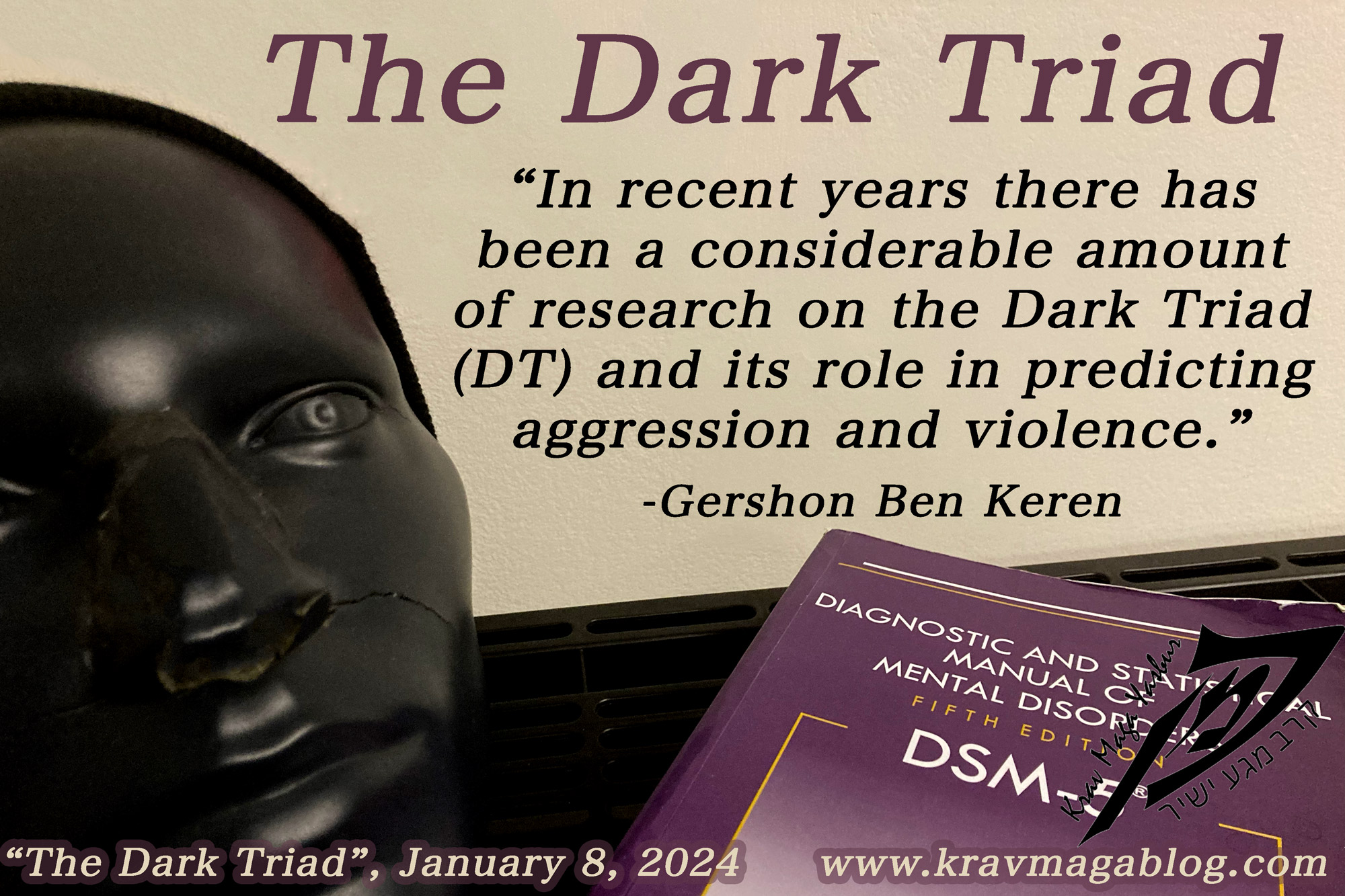In recent years there has been a considerable amount of research on the Dark Triad (DT) and its role in predicting aggression and violence. The Dark Triad is made up of three socially aversive personality types. One of these is a personality disorder recognized by the DSM, i.e., narcissism, with the others being psychopathy, that although not recognized explicitly within the DSM is clinically definable and measurable (and falls under/within the DSM’s anti-social personality disorder), and Machiavellianism, a less well researched/established personality trait, but still scientifically measurable, that was first defined in the 1960’s by psychologists, Richard Christie and Florence Geis (who developed the Mach IV test, which has become the standard self-assessment test, to diagnose and measure the trait). Although the term the “Dark Triad” first appeared in a paper that was published in 2002 by Paulhus and Williams, the idea of narcissism, psychopathy and Machiavellianism sharing common traits was first put forward by McHoskey et al., who argued that the three disorders/traits were ostensibly the same thing e.g., there were no real differences between psychopathy, narcissism, and Machiavellianism. However, whilst all three do share many similarities, such as callousness and low agreeableness (two solid predictors of aggression and violence), there are also differences between them e.g., individuals with psychopathy tend to be impulsive, whilst a significant trait of Machiavellianism is that of calculation/planning etc. Also, narcissism is not a “singular” disorder but is made up of phenotypes e.g., there are “grandiose” and “vulnerable” narcissists who may express themselves in very similar ways, but the motivations for doing so are somewhat different. One of the values of the Dark Triad is that it brings to the forefront anti-social behaviors that may be common to different personality disorders and traits e.g., someone might fall short of a clinical definition of either/or narcissism and psychopathy but express themselves in a way that it is dangerous and harmful to others, which is more important for violence prevention than making a clinical definition. In this article I want to take a look at the Dark Triad and how it may help us to better understand violent offending.
One characteristic of the Dark Triad that can lead to aggression and violence is callousness i.e. a lack of empathy/sensitivity and coldness that can lead to cruelty. Whilst narcissists, psychopaths and those who score highly on the Mach IV test, may engage in cruel acts, they do so for different reasons e.g., a narcissist may verbally attack someone to re-establish their self-esteem, whereas a psychopath may do so to relieve boredom and as an act of excitement, whilst someone having the trait of Machiavellianism will use a person with a sense of indifference in order to achieve a particular goal. Whilst the three traits/disorders engage in cruelty for different reasons and motivations, they share one thing in common: people are there to be used for their own gain, whether that is practical, emotional, or psychological etc. All of these three traits/disorders also exhibit non-existent or low levels of remorse or guilt. The psychopath lacks the emotional intelligence to experience such feelings – though they may be cognitively able to “fake” remorse if it benefits them to do so. The narcissist believes their feelings are more important than others, and so doesn’t see other peoples’ experiences as relevant, and those individuals exhibiting Machiavellian traits would rationalize what they did, that caused another harm and suffering, as the ends/outcome justifying the means i.e., you can’t make an omelet without breaking some eggs etc. All of these traits/disorders share the belief that others are there to be exploited and manipulated. From a personal safety/relationship perspective it is more productive to identify this than the underlying motivation and reason that someone has for doing so.
There has been a push by some to expand the Dark Triad to include other socially aversive personality disorders and traits, such as borderline personality traits and moral disengagement etc., however amongst those looking to do this, the consensus has been to include sadism, and this has led to the creation of the Dark Tetrad i.e., the Dark Triad, plus sadism. Whilst the psychopath or those who are Machiavellian in nature don’t necessarily benefit emotionally from the suffering of others – it’s either part of the means to and end, or a slight relief from boredom – it is the pain and the suffering itself which motivates the sadist. Whilst a large percentage of the prison population have anti-social personality disorder, which covers psychopathy, those diagnosed as sadists are not great in number, and are more likely to be the perpetrators of sexual homicides, making them statistically, a very small and specific group.
One of the major problems with just about all large-scale research on these personality disorders and traits, is that samples tend to be drawn either from prison populations or university students; two groups which from a socio-economic perspective tend to exist at two opposite ends of a spectrum. This means that more representative societal groups need to be studied in order for a fuller, more realistic, and relevant picture to be gained. Whilst there are often commonalities of behavior between certain disorders there are also differences in the way offenses may be committed e.g., someone with psychopathy isn’t going to care too much about risk and may commit an offense because at the time it excites them to do so, even when the chances of getting caught are high. Whereas someone with Machiavellian personality traits is likely to plan and then execute their offense with the reduction of risk being a significant factor.
Share:

Gershon Ben Keren
2.8K FollowersGershon Ben Keren, is a criminologist, security consultant and Krav Maga Instructor (5th Degree Black Belt) who completed his instructor training in Israel. He has written three books on Krav Maga and was a 2010 inductee into the Museum of Israeli Martial Arts.
Click here to learn more.

